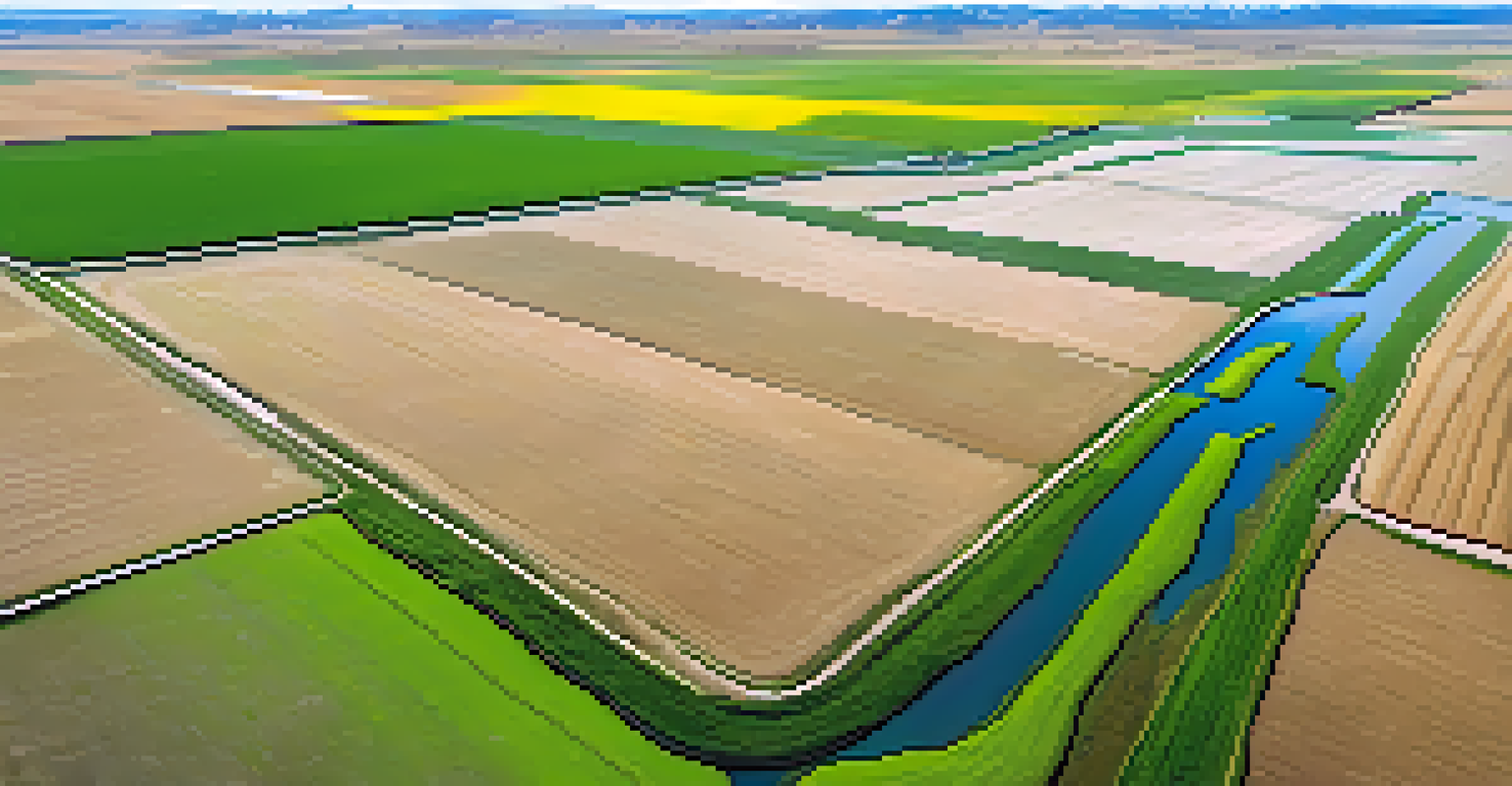The Role of Snowpack in Colorado's Water Supply and Economy

Understanding Snowpack and Its Importance
Snowpack refers to the accumulation of snow that builds up in mountainous regions during winter. In Colorado, this natural reservoir is crucial for replenishing water supplies as it melts in the spring and summer. Essentially, snowpack acts like a giant sponge, storing water that feeds rivers and lakes, which are vital for both ecosystems and human use.
Water is the driving force of all nature.
The amount of snowpack directly influences the water availability for agriculture, municipal use, and recreational activities. For farmers in the San Luis Valley, for example, the spring melt provides necessary irrigation for crops. Without a sufficient snowpack, water scarcity can lead to drought, impacting not just agriculture but also local economies tied to water resources.
Moreover, snowpack plays a significant role in maintaining river flows, which are crucial for fish habitats and other wildlife. When snow melts gradually, it helps maintain a consistent flow of water, preventing the extremes of flooding or drought. Understanding this balance is essential for managing Colorado's water supply sustainably.
The Economic Impact of Snowpack on Agriculture
Agriculture is a major component of Colorado's economy, with the state's farmers heavily relying on snowpack for irrigation. The melting snow provides the water needed for crops like corn, alfalfa, and various fruits and vegetables. A robust snowpack means a thriving agricultural sector, which in turn supports local jobs and economies.

When snowpack levels are low, farmers face significant challenges, including reduced crop yields and increased costs. This can lead to a ripple effect, impacting not only those directly involved in agriculture but also related industries, such as food processing and distribution. A struggling agricultural sector can contribute to higher food prices and economic instability in rural areas.
Snowpack Supports Water Supply
Snowpack serves as a vital natural reservoir, replenishing water supplies for agriculture, urban areas, and ecosystems as it melts.
In contrast, when snowpack levels are adequate, it can lead to bumper harvests and lower prices for consumers. The economic benefits extend beyond the farm; they touch restaurants, grocery stores, and even tourism, as visitors flock to Colorado for its natural beauty and agricultural bounty.
Snowpack's Role in Urban Water Supply
Urban areas in Colorado, such as Denver and Colorado Springs, also depend on snowpack for their water supply. These cities rely on reservoirs filled by the snowmelt to provide drinking water to millions of residents. As populations grow, the demand for this precious resource increases, making snowpack an essential consideration in urban planning.
We do not inherit the earth from our ancestors; we borrow it from our children.
Water management agencies closely monitor snowpack levels to forecast water availability for the coming months. This information helps them make informed decisions about water conservation measures and infrastructure investments. For instance, when snowpack is below average, cities may implement stricter water use policies to ensure sustainable supply.
Additionally, urban landscapes can be affected by snowpack variability, leading to challenges like flooding when melting occurs too quickly. Effective management of both snow and water resources is vital for balancing urban needs with environmental sustainability.
Impact of Climate Change on Snowpack Levels
Climate change poses a significant threat to snowpack levels in Colorado, with rising temperatures leading to earlier snowmelt and reduced accumulation. As winters become warmer and shorter, the amount of snowpack can decrease, impacting both water supply and the economy. This shift can have dire consequences for agriculture and urban water systems that depend on predictable snowmelt patterns.
Research indicates that Colorado could see a reduction in snowpack by up to 30% by the end of the century if current trends continue. This decline not only threatens water availability but also the livelihoods of those who rely on consistent snowpack levels. Farmers, urban planners, and water managers must adapt to these changes to safeguard their resources.
Economic Impact of Snowpack
A robust snowpack positively influences Colorado's agricultural economy, leading to lower food prices and job creation in related industries.
Communities are beginning to explore innovative solutions to address these challenges, such as water conservation techniques and alternative water sources. By understanding the risks associated with climate change, stakeholders can better prepare for a future where snowpack variability may become the norm.
The Recreational Value of Snowpack
Snowpack is not only crucial for water supply but also for Colorado's thriving recreational industry. The state's ski resorts and winter sports activities heavily depend on consistent snowfall. A healthy snowpack means more opportunities for skiing, snowboarding, and other winter sports, attracting tourists from around the world.
In fact, the winter tourism sector generates billions of dollars in revenue for Colorado. When snow levels are high, resorts see increased visitors, leading to job creation and economic growth in surrounding communities. Conversely, a lack of snow can lead to reduced tourist numbers, affecting local businesses and the economy.
Moreover, the recreational value of snowpack extends beyond winter sports. Activities like snowshoeing, sledding, and even winter hiking offer residents and visitors a chance to connect with nature. Maintaining healthy snowpack levels ensures that these recreational opportunities remain accessible, enhancing the overall quality of life in Colorado.
Community Awareness and Conservation Efforts
Community awareness about the importance of snowpack is vital for fostering sustainable practices. Educational initiatives can help residents understand their connection to snowpack and the role it plays in their daily lives. By promoting water conservation and responsible land use, communities can contribute to maintaining snowpack levels.
Local organizations and governments often collaborate on initiatives aimed at protecting watershed areas and enhancing snow retention. For instance, programs that involve tree planting or soil health improvement can positively impact snowpack by promoting better water absorption and retention. Engaging the public in these efforts is key to their success.
Climate Change Threatens Snowpack
Rising temperatures due to climate change pose serious risks to snowpack levels, impacting water availability and economic stability.
Additionally, community involvement can lead to innovative solutions for water management. When citizens are informed and engaged, they can advocate for policies that prioritize sustainable water use and climate resilience. Together, communities can make a significant difference in preserving Colorado's vital snowpack.
Future Outlook: Balancing Needs and Sustainability
Looking ahead, balancing the diverse needs for water in Colorado will be crucial for sustainability. As climate change and population growth continue to exert pressure on water resources, stakeholders must work collaboratively to find solutions. This may involve revising water management strategies and investing in new technologies for conservation.
Water reuse and recycling technologies, for example, can help alleviate the demands on snowpack and reservoir systems. By treating and reusing wastewater, municipalities can reduce their reliance on natural sources, ensuring that there’s enough water for everyone. This approach not only supports urban needs but also helps preserve the vital snowpack for agriculture and recreation.

Ultimately, the future of Colorado's water supply and economy hinges on informed decision-making and community involvement. By understanding the critical role of snowpack and working together, Coloradans can ensure a sustainable future where water resources are managed wisely for generations to come.